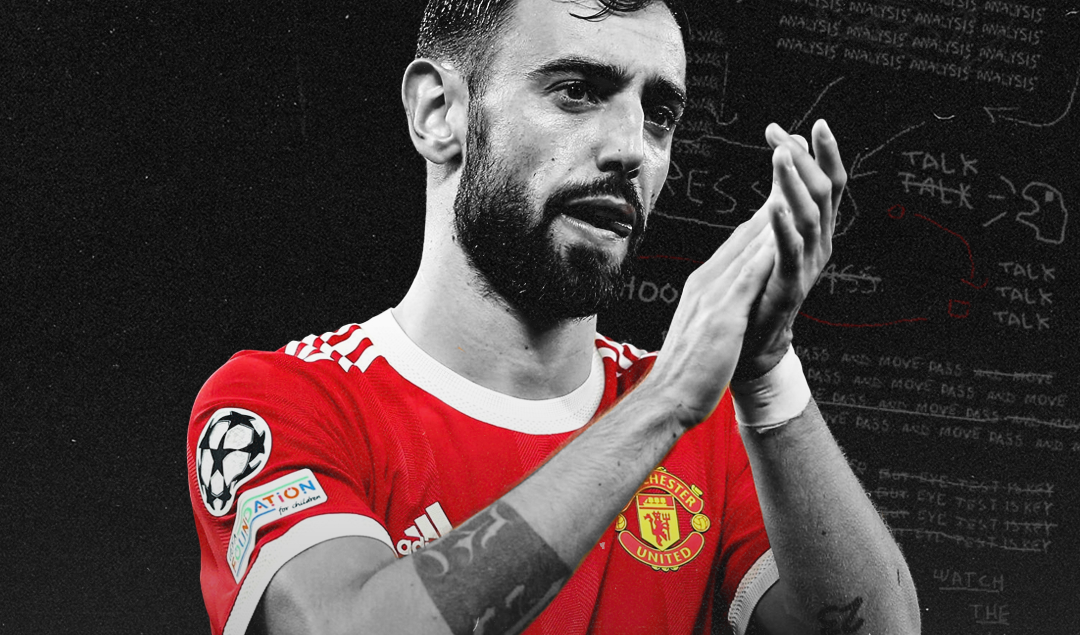How Portugal Avoided an Early Euros Exit Against Slovenia
Since taking charge of the Portugal national team, Roberto Martinez has suffered just one defeat — a 2-0 friendly loss in Slovenia. Portugal nearly suffered another defeat to Slovenia in the Round of 16, only for goalkeeper Diogo Costa to come up clutch on several occasions and see the Seleção through to the quarterfinals.
Both teams had opportunities to close out the match from the opening minute, with Slovenia having several opportunities to break the flow and frighten the Portuguese defence with fast transitions and Portugal being energetic and eager to score. Portugal’s skill inside the box was lacking and didn’t put Jan Oblak to the test until João Palhinha’s goal-frame strike at the conclusion of the first half-hour.
Pepe and Rúben Dias’ experience in the back line helped to repel Slovenian attacks, but Pepe’s fall may have recreated the historic “Gerrard Slip” if it weren’t for Diogo Costa’s heroics in the last moments of the match. This save forced the game into extra time, where Cristiano Ronaldo missed the chance to kill the game from the penalty spot which then later went to penalties; Diogo Costa became the hero of the nation by pulling of three saves in the shootout to help Portugal advance to the quarter-finals after winning 3-0 in the penalty shootout.
Diogo Costa: The Present and Future of Portugal’s Goalkeeper Position
Although there were times during the match when either team may have won, Portugal advanced to the next round because to the genius of Diogo Costa. We will dissect Portugal’s performance against Slovenia in this tactical study, drawing conclusions about the areas to focus on ahead of Saturday’s quarterfinal matchup against France.
Attacking & Build-Up Analysis
Portugal used their traditional 4-2-3-1 formation to open the game, looking to capitalize on their errors from the previous encounter. It became obvious that the Portugal midfield lost their talisman, Bruno Fernandes, as the team was unable to win the match by depending solely on crosses and individual brilliance. He was the crucial component lacking in the game versus Georgia because of his positioning and movement, which created space for forwards to make runs.
As usual, Bruno Fernandes was the focal point of the midfield machine that enabled the team to generate more chances in the decisive third quarter. He accumulated more points than anyone else to emerge as the most valuable player in terms of attack and build-up.
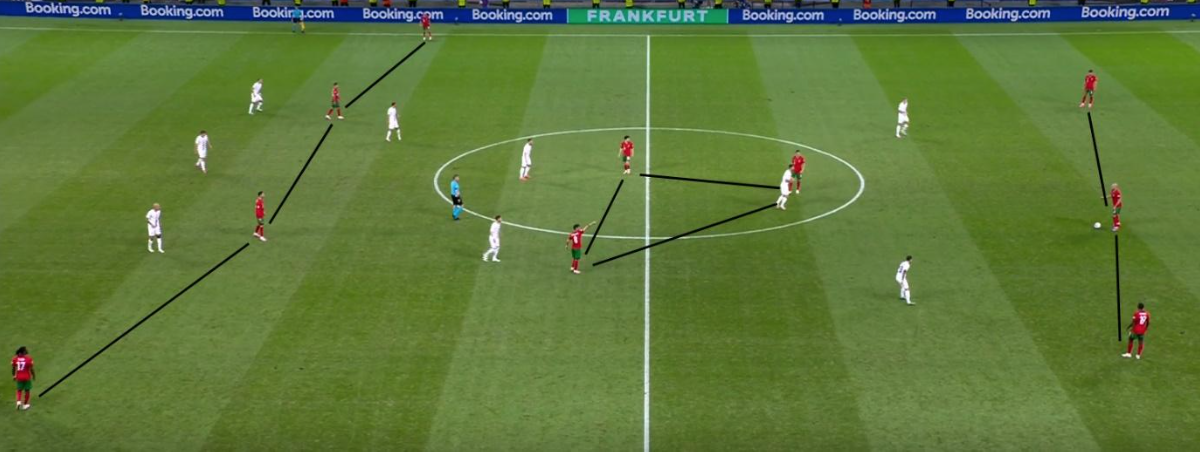
With a 4-2-3-1 formation at first, João Cancelo, who overlapping wingback, offered additional stability. Nuno Mendes, another wingback, mostly played as the third centre back in the three-man defence and established a lovely combination and connection to fend off Slovenian advances.
Portugal appeared to be in a triangle formation in the mid-3rd when Bruno Fernandez dropped down to assist the two pivots, Vitinha and Palhinha, and Cancelo joined the attacking line. The idea behind this 3-3-4 formation during the build-up was to breach the opposition’s defensive line by allowing Cancelo to fall and pull a man, and Vitinha to sprint to the gaps left by the pulling defender.
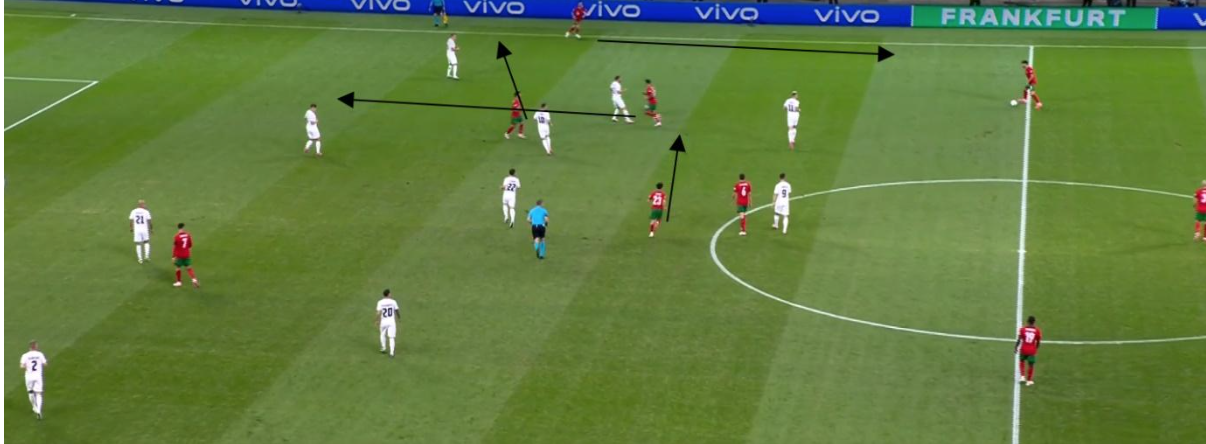
In order to capitalize on spaces left by the opposition when man-marking, Martinez has his players rotate for moves, as seen in the image above. In the 3-3-4 formation, Martinez was able to improvise on the field thanks to the radical ways the wingers on the touchlines offered depth.
When Ruben Dias gets the ball in the photo, Bernardo Silva on the touchline drives down to catch it and drags a rival player with him. This allows Cancelo to break into the space, where Fernandes takes Silva’s spot and Vitinha falls in line to provide more support, switching positions to hurt the opposition by making them feel their own pain.
Although it hasn’t always worked, shifting positions to disrupt the adversary and make them feel bad about themselves has often been effective. Portugal was able to take advantage of the openings generated at the edge of the box in this game to whip in a cross or slide it down to produce Shot Creating Actions, which allowed the team to have two goals (Expected Goals), but their poor finishing skills gave them a fright.
Portugal played carelessly at first, but they seem to be settling into a style of play that the manager has found effective. Portugal moved through the midfield in a very effective and promising manner, but in order to achieve the desired outcome, their final product needs to be strong and self-assured. Portugal has also struggled in front of goal because of players like Ronaldo, who plays the position of Second Striker by slipping under opponents’ feet and without really posing a threat.
Defensive Analysis
Palhinha was arguably the best player for Portugal on the pitch, he was positioned right above the back line adapting the role of a defensive midfielder in defensive transition. He provided stability and covered angles that hurt Portugal in the previous game against Georgia. Palhinha is the player we will be choosing to explain how this team works in the defensive transition.
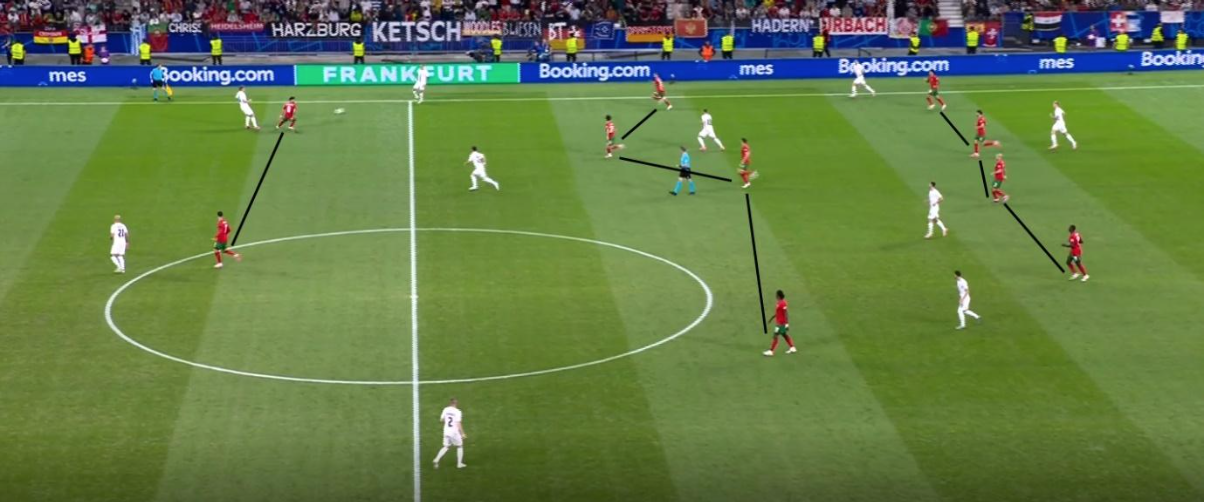
Portugal started the defensive transition in their customary 4-4-2 formation before focusing on the second balls and spreading the play. Palhinha took his position just above the back line of four, who were always dependable in protecting the last line. This allowed the attackers and midfielders to press high up the pitch and efficiently man-to-man. Palhinha moves into the space between the two centre backs, allowing the defence to spread out and obstruct any potential passes intended to break the line.

Palhinha was the answer in the previous game as Portugal was unable to cover spaces left open by the fullbacks during defensive transitions due to the absence of a pivot in the role of a defensive midfielder. In order to give the squad more stability when pushing high up the field, he was assigned to guard the back line and maintain a proper line with Vitinha.
Despite being this team’s first line of defence, he helped to move the play area and had a couple quiet shots that went in, so offensively he proved to be a valuable addition. He was arguably the first Portugal to disturb the opposition keeper when he fired a low powerful shot towards the bottom right corner with caressed the framework of the goal.
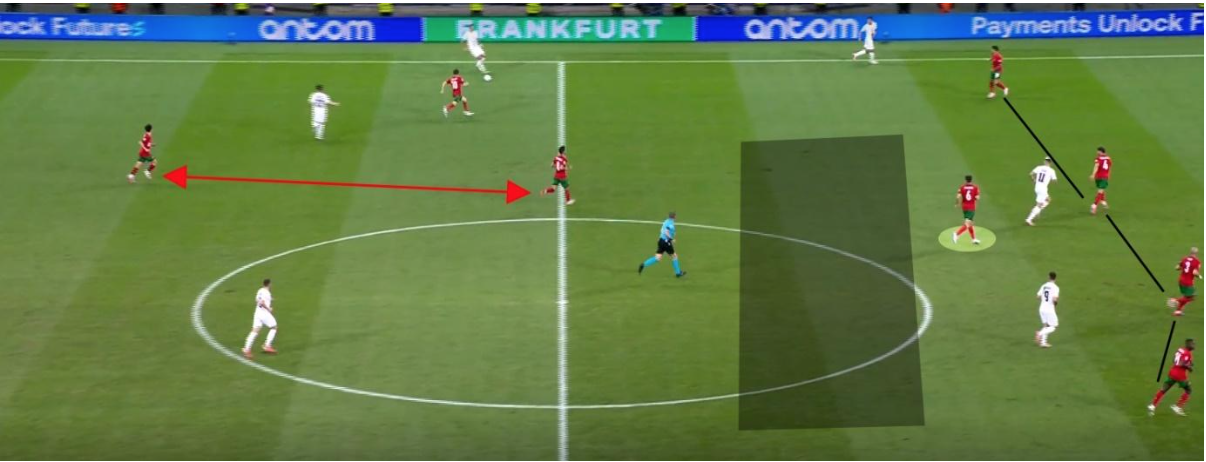
Palhinha was strategically positioned to cover the area in front of him by blocking certain angles that hurt the team during defensive transitions or counterattacks. He was noticed in front of the two center backs. Defensive duties were one area in which players adopted new roles, as was previously discussed in this article.
When Vitinha takes up space on the field, he marks the player next to him by remaining in his zone throughout a possession shift. As seen in the image, Bruno Fernandes and Vitinha are defending the zones during the change of possession even though they are not in their usual positions.. This ideology of defending was seen with every player excluding the two centre backs and the defensive mid-fielder Palhinha in front of them.
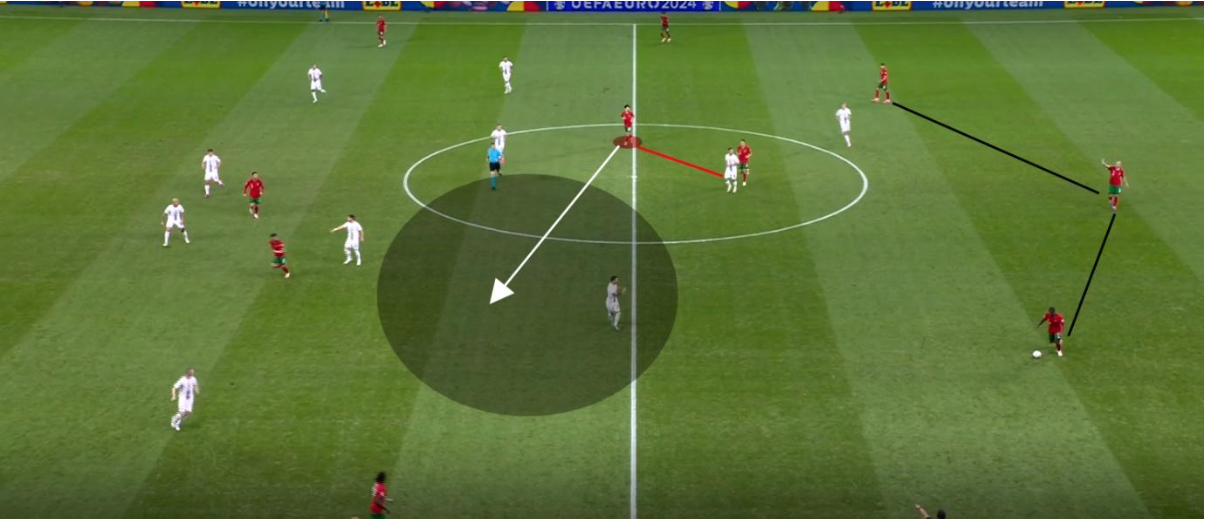
During the game, Portugal had some frightening moments that may have cost them in regulation time. Because Vitinha and Palhinha were continually adopting the shape of a line where one edge had a small area to cover and the other had a large area of space to cover, they were crucial in the midfield for defensive transition. This mid-field configuration, along with the back three, created a pendulum-like movement, with Vitinha serving as the pendulum’s far end and Palhinha combining defense and mid-field.
This strategy had drawbacks since Vitinha needed more time to cover ground and the opponent had more opportunity to work and move quickly during the time it took for him to change positions. An even more effective defensive strategy would have involved assigning Vitinha and Palhinha zones from the centre of the pitch (in front of the centre back) to the zones on either side, creating more of a see-saw effect that would continue to oscillate until the very end.
Conclusion
With the exception of the last minute, Portugal controlled every aspect of the game and executed their plan exactly as the manager would have desired. In order to exert more pressure on superior opponents in the upcoming games, the Portuguese players must become more effective in front of goal. They will play France in the quarterfinals, which is a rematch of the 2016 finals in which Portugal won. Given the calibre of the French team, they risk suffering severe consequences if they miss their opportunities.
The defence had some terrifying moments that may have cost them the game at different points, but overall, the transitions were sloppy but effective enough to prevent the opposition from testing their keeper. The defence would feel more at ease against a team that prefers to maintain possession and flip sides frequently if Palhinha and Vitinha were paired in the midfield and numbers were placed there rather than man-man pressure.
By: Sive Vishwa / @sive_vishwa
Featured Image: @GabFoligno / Charlotte Tattersall – UEFA
